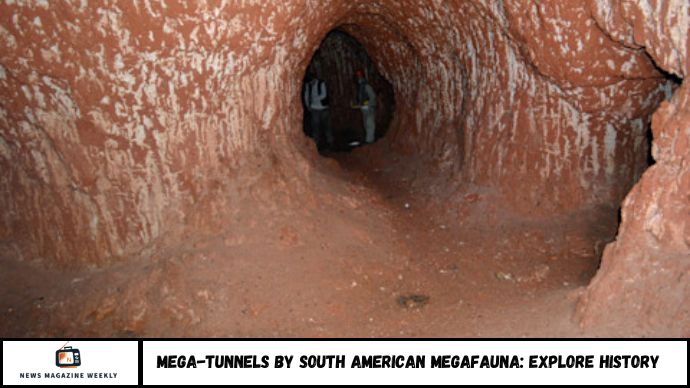Explore the Ancient Mega-Tunnels Dug by South American Megafauna
Massive tunnels found across Brazil and other parts of South America—some large enough to walk through—have puzzled scientists for decades. These mega-tunnels, also known as paleoburrows, are believed to be the handiwork of extinct South American megafauna, such as giant ground sloths and glyptodonts. This article explores what these tunnels are, how they were discovered, what creatures made them, and what they reveal about ancient ecosystems and behavior. With updated research and scientific evidence, we’ll uncover the truth behind these underground mysteries.
The Accidental Discovery That Changed What We Know About Prehistoric Life
In 2010, geologist Amilcar Adamy of the Brazilian Geological Survey (CPRM) followed up on rumors of a strange cave tucked into a forested hillside in Brazil’s Rondônia state, near the Bolivian border. He found it—a yawning tunnel carved into the slope—but couldn’t fully explore it that day. Still, something about it was off.
Unlike the nearby limestone caves formed by water erosion, this one had a smooth floor, rounded ceiling, and no signs of natural geological formation. “I’d never seen anything like it before,” Adamy recalled. “It really grabbed my attention. It didn’t look natural.”
Around the same time, 1,700 miles away in southern Brazil, geologist Heinrich Frank spotted an unusual hole in a highway construction site. He returned later and crawled inside. It ended in a narrow shaft—and the ceiling was scratched with what appeared to be massive claw marks.
Neither geologist could explain these formations with traditional geology. Eventually, they reached the same astonishing conclusion: these were not caves. They were paleoburrows—prehistoric mega-tunnels carved by extinct giants like giant ground sloths, tens of thousands of years ago.
What Are Paleoburrows? A Prehistoric Puzzle
Paleoburrows are large, ancient tunnels—sometimes extending over 100 meters in length and 1.5 meters high—found primarily in southern Brazil. Unlike caves, these aren’t formed by natural erosion but rather mechanical digging by animals.
Key Characteristics:
- Rounded ceilings and claw marks clearly visible on walls
- Found in regions with no geological processes to explain them
- Sometimes branching or layered, indicating complex behavior
According to Dr. Heinrich Frank, a Brazilian geologist who has documented hundreds of these structures, many of these tunnels are likely over 8,000 to 10,000 years old.
Who Were the Giant Diggers? Meet the Megafauna
The primary suspects behind these tunnels are extinct species from the Pleistocene epoch.
Likely Tunnel Builders:
- Giant Ground Sloths (e.g., Glossotherium):
- Size: Up to 4 meters long
- Weight: Over 1,000 kg
- Strong claws ideal for digging
- Glyptodonts (armored relatives of armadillos):
- Known for their powerful forelimbs
- Could burrow for shelter or protection
These creatures didn’t just roam the land—they reshaped it.
Why Were These Mega-Tunnels Dug?
1. Shelter from Climate and Predators
The Ice Age brought extreme environmental stress. These tunnels likely provided:
- Stable temperatures
- Safety from predators like saber-toothed cats
2. Social Behavior and Reproduction
Some paleoburrows contain side chambers or multiple entry points, hinting at:
- Group living or nesting behavior
- Complex social interactions
3. Territorial Markings or Migration Paths
The size and scale of some tunnels suggest:
- Repeated use over generations
- Long-distance travel or migration routes
Recent Discoveries and Scientific Insights
- In 2023, researchers in Santa Catarina, Brazil, mapped a paleoburrow over 600 feet long, with multiple chambers and side tunnels.
- Over 2,000 paleoburrows have been identified across South America, especially in Brazil, Uruguay, and Argentina.
- Ground-penetrating radar and drone imaging now help uncover new tunnel systems without excavation.
Fact: A single giant sloth could move up to 4 metric tons of soil in its lifetime.
Why Paleoburrows Matter Today
Understanding these tunnels isn’t just about curiosity—it’s about reconstructing ancient ecosystems, including:
- Climate patterns of the Pleistocene
- Animal behavior and adaptation
- Human-prehistoric animal interactions (some paleoburrows show signs of later human use)
As modern climate concerns grow, studying how ancient creatures adapted to environmental change offers valuable insights.
Frequently Asked Questions (FAQs)
1. What are paleoburrows?
Prehistoric tunnels likely dug by extinct giant animals such as ground sloths and glyptodonts.
2. Where are they found?
Mainly in Brazil, Uruguay, and Argentina across forested and rocky regions.
3. How big are these tunnels?
Some are over 1.5 meters high and hundreds of feet long—big enough for a person to walk through.
4. Who dug the tunnels?
Likely Pleistocene megafauna like giant sloths and armored glyptodonts.
5. What were they used for?
Shelter, protection, nesting, and possibly migration or social behavior.
6. Can I visit a paleoburrow?
Yes some sites in Brazil allow tours or guided visits to safe, preserved tunnels.
Conclusion
The massive tunnels etched into South American soil are more than just empty spaces—they are time capsules. Carved by now-extinct megafauna, these structures tell a story of survival, adaptation, and ingenuity. As researchers continue to map and study them, paleoburrows offer clues not only to the past but also insights into our planet’s ecological future.

